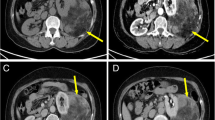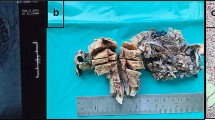Abstract
Angiomyolipoma is the most common mesenchymal renal tumour, the clonal origin of which has recently been demonstrated. It is composed of varying amounts of blood vessels, smooth muscle and fat. In this report, we describe a renal angiomyolipoma, which is unusual owing to the presence of a lymphangioleiomyomatosis-like component, occurring in a 41-year-old woman suffering from sporadic lymphangioleiomyomatosis. The diagnosis was based on histopathological and immunohistochemical findings. The tumour consisted of an intimate admixture of two components: one was typical of a classical angiomyolipoma and the other was reminiscent of lymphangioleiomyomatosis. HMB45 positivity was found on 5% of the cells of the angiomyolipoma component. Ten percent of the nuclei of the lymphangioleiomyomatosis and angiomyolipoma components expressed oestrogen receptors and 5% progesterone receptors. This case illustrates a very unusual pattern of a renal angiomyolipoma containing a lymphangioleiomyomatosis-like component. The oestrogen and progesterone immunoreactivity suggests that angiomyolipoma could be hormonally dependent. Therefore, we have emphasised the morphological and immunohistochemical similarities between angiomyolipoma and lymphangioleiomyomatosis.
Similar content being viewed by others
Author information
Authors and Affiliations
Additional information
Electronic Publication
Rights and permissions
About this article
Cite this article
Colombat, M., Boccon-Gibod, L. & Carton, S. An unusual renal angiomyolipoma with morphological lymphangioleiomyomatosis features and coexpression of oestrogen and progesterone receptors. Virchows Arch 440, 102–104 (2002). https://doi.org/10.1007/s00428-001-0553-1
Received:
Accepted:
Published:
Issue Date:
DOI: https://doi.org/10.1007/s00428-001-0553-1




